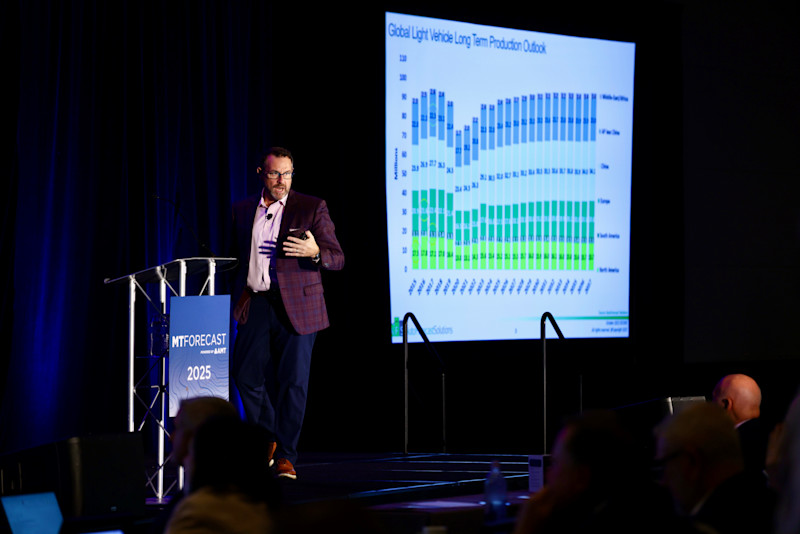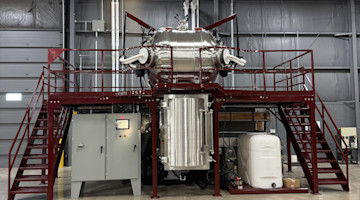From October 15–17, industry leaders, economists, and senior executives gathered for MTForecast 2025, an event focused on the future of the manufacturing technology market. Against a backdrop of economic uncertainty, shifting global trade dynamics, and rapid technological evolution, the conference offered attendees a data-rich, forward-looking view of the sector’s trajectory. This year’s event emphasized strategic agility, cross-sector resilience, the impacts of shifting trade dynamics, and the growing role of artificial intelligence in shaping business decisions. What follows are some of the highlights from MTForecast 2025 and what your business needs to know going into next year.
Headwinds Ahead for Manufacturing Technology After Resilient 2025
The economic tone of MTForecast 2025 was one of cautious optimism, tempered by the realities of inflation, policy volatility, and global trade disruptions. Presenters from Oxford Economics, ITR Economics, the Federal Reserve Bank of Chicago, and AMT – The Association For Manufacturing Technology provided a multifaceted view of the manufacturing landscape.


Sean Metcalfe of Oxford Economics stated that global industrial output is projected to grow 2.7% in 2025, but slow to 1.9% in 2026, reflecting front-loaded production and tariff-related uncertainty. The machine tool sector showed resilience in early 2025 in the face of trade disruption and will finish the year in positive territory, but the industry is expected to contract slightly in 2026 before rebounding with 8.2% growth in 2027. Data from the U.S. Manufacturing Technology Orders Report by AMT buttresses this view, with YTD orders through September 2025 up 17.3% over the same period in 2024.
Data from the Gardner Capital Spending survey revealed a more nuanced outlook. While respondents indicated a dramatic decline in capital expenditure (CapEx) spending next year, the results were likely influenced by negative headlines during the survey period. However, monetary policy has moved in a more favorable direction since then, and there continues to be progress in trade policy. The respondents’ shift toward used machinery and cost-efficient solutions suggests a more conservative approach to capital allocation, especially among job shops and small manufacturers.
From a macroeconomic perspective, Daniel Sullivan from the Federal Reserve Bank of Chicago highlighted a rebound in GDP growth in Q2 2025 and strong business investment in data centers, AI infrastructure, and automation, hinting at a potential productivity surge reminiscent of the 1995–2005 boom. There was also caution among the economists at MTForecast that easing inflation was likely over, with tariffs and increasing energy prices leading to upward pressure on inflation over the next year. Furthermore, while the labor market has softened in recent months, the unemployment rate remains fairly low, and a tight labor market will likely be a long-term trend due to demographic realities.
Additionally, the economists at the conference unanimously cautioned that policy uncertainty and geopolitical tensions could change rapidly and dampen momentum if not managed strategically. As Metcalfe stated in his presentation, “The machine tool sector and the wider economy have been very resilient this year in the face of multiple headwinds...[but] we expect to see a weaker demand environment next year with inflation and lower equipment investment reducing machine tools demand at the beginning or the first half of the year.”
End-Market Industry Highlights: Bright Spots and Pressure Points




MTForecast 2025 also included insights from numerous industry experts who offered a sector-by-sector breakdown of manufacturing’s end markets, revealing a landscape of both opportunity and challenge. The mixed market outlooks reinforced the importance of strategic positioning and scenario planning to guide organizations through uncertain times.
The automotive market appears to be stabilizing, but there is a long-term threat to U.S. OEMs from low-cost Chinese manufacturers. Meanwhile, aerospace and defense markets remain a bright spot as commercial air travel and jet demand are strong, coupled with rising global defense spending. Construction spending is buoyed by strong investments in AI infrastructure, but agriculture is in a rough spot as farmers are squeezed and demand for new equipment has been slow; however, an upswing in growth could be on the way in 2026.
Tariffs and Trade: A Persistent Disruptor


Trade policy and tariffs were central themes throughout the conference, with presenters warning of their disruptive impact on supply chains, pricing, and investment decisions. Section 232 and 301 tariffs, along with the tariffs imposed under the International Emergency Economic Powers Act (IEEPA) have created an environment of legal uncertainty and elevated costs, with effective rates across the board potentially settling around 15-20%. Companies face challenges in navigating enforcement actions, adjusting sourcing strategies, dealing with margin pressures, and if some tariffs are struck down in court, could face issues securing refunds.
The ripple effects are being felt across sectors:
Some industries are seeing price spikes and delivery delays.
Some OEMs are shifting production to Mexico.
Manufacturers are reevaluating supplier relationships, with many exploring domestic alternatives or automation to offset labor and logistics costs.
The consensus among presenters was clear: although the effective rate may change, the tariffs are here to stay, and businesses must build resilience through strategic sourcing, policy engagement, and operational flexibility.
AI, Decision Intelligence, and Marketing Strategy
One of the most forward-looking themes at MTForecast 2025 was the integration of artificial intelligence and decision intelligence (DI) into manufacturing strategy. While AI adoption is accelerating, Dr. Lorien Pratt noted that up to 95% of generative AI projects fail due to poor alignment with business goals and lack of structured implementation.


Decision intelligence offers a solution by connecting data, AI models, and human judgment to specific outcomes. Tools like Causal Decision Diagrams (CDDs) help organizations visualize the impact of decisions across departments, enabling smarter investments and faster pivots. Having scenario planning or decision matrices can help manufacturers make decisions more quickly and confidently amid continual chaos. On the marketing and sales front, sessions emphasized the importance of aligning messaging with business outcomes. Much the same way that AI should be aligned with business goals, your AI strategy is not one-size-fits-all and should always be driven by the needs of the business first.
Key takeaways included:
Shifting from product-centric to customer-centric narratives
Using data to optimize lead generation and conversion
Positioning companies as trusted advisors rather than transactional vendors
The overarching message: Marketing and sales must evolve alongside technology, leveraging insights and automation to drive growth in a competitive, data-driven environment.
Final Thoughts
MTForecast 2025 painted a complex but navigable picture of the manufacturing landscape. Most speakers were in agreement. While macroeconomic headwinds and policy uncertainty persist going into 2026, the sector is adapting and there are still pockets of opportunity in key industries. And despite the challenges, attendees remained optimistic about the future of manufacturing. Forecasts suggest that any downturn in 2026 will be short-lived, with the market bouncing back strongly.
AMT President Doug Woods stated, “Our industry thrives on solving problems and turning uncertainty into opportunity. With the adoption of AI and digital technologies, rising energy production, strong consumer demand, and increased foreign direct investment in the United States, it’s an exciting time to be in manufacturing.”
As manufacturers look ahead to 2026 and beyond, the insights from MTForecast offer a valuable roadmap for thriving in an era of transformation.
To keep abreast of the latest forecasts and outlooks, be sure to join AMT at the Winter Economic Forum on Friday, January 30. Registration is complimentary, and there is an opportunity to join in-person or online.






